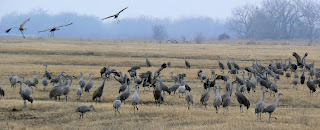Migratory birds rest at Nebraska's Platte River
 Image (792K) from Wikipedia's article about Sandhills Cranes
Image (792K) from Wikipedia's article about Sandhills CranesEach year, 500,000 (or more) Sandhill cranes spend a few weeks in Nebraska's Platte River Valley as part of their long migratory trip north.
On and along the wide, shallow Platte River, the birds rest and build up fat reserves for the rest of the trip north. They need enough strength to fly, and then to mate and reproduce at their final destination.
The Sandhill cranes, tall gray birds with a 6-foot wingspan, begin arriving in February. Their presence in the Platte River wetlands triggers a migration of birdwatchers to the area that ends only when the last cranes leave in April.
Each morning, the cranes rise up from the river in flocks, and each night, the flocks land on the water together. They spend their days in the fields surrounding the river, feeding on insects and fallen grain and dancing with each other (pre-mating behavior.)
Rowe Sanctuary and the Crane Cam
The Rowe Sanctuary on the Platte River south of Gibbon, Nebraska, provides a 2000-acre safe haven of wetlands and roosting area along the riverside. The Sanctuary offers a number of blinds from which the birds can be observed on the river. Tours for individuals or groups can be arranged. Sometimes the cranes land (or take off) just a few yards from the blinds.
Many of us will never make it to one of the blinds, but we can experience the birds through the National Geographic Crane Cam. The website states that the best viewing hours are 6:30-8:30 AM CST and 7:00-9:00 PM CST. A "Real Player" plugin is needed.
At any time of the day, you can see and hear birds on the river via the webcam. Hundreds of thousands of ducks and geese are in the area along with the cranes.
Note: This article is about the 2008 Crane Cam. See this blog article for information about the 2010 Crane Cam
Rowe Sanctuary Volunteer
Carolyn Hall of Bassett, Nebraska, (my old hometown) has spent the past week working at the Rowe Sanctuary. She has been taking tour groups to the blinds, running the webcam, tending the guest register, cleaning restrooms, helping in the gift shop, and being useful in just about any way she can. It's been a busy week, but she's enjoyed it. Her daily letters included this account:
I helped with the strawbale blind tonight. We had 24 people and two college students. We got to the blind about 6:40 and gave our speel about the birds and the river, when at 7:20 the first cranes landed on the edge of the river about 1/4 mile downriver. From then to 8:10, it was flock after flock of birds landing. We must have had at leat 10,000 cranes and a few geese within 1/4 mile of us. In the end they were landing right in front of the blind. We managed to get everyone out of the blind and back to the parking lot without spooking the birds. We had a happy group of people!
Source: E-mail from Carolyn Hall, March 15, 2008.
Shikepokes, shypokes, and Sandhill cranes
When I was growing up in the Nebraska Sandhills, we often saw tall birds at our lakes, ponds, and marshes in the spring. We called them "shikepokes."
A few years ago, I read that Sandhill cranes are sometimes called "shypokes" or "preacher birds." Then, I realized that the shikepokes of my memories may have been Sandhills cranes, passing through Nebraska during migration.
However, the name "shikepoke" can also refer to various herons and bitterns. My memory of our shikepokes' appearance is not too clear, so I don't know if they were Sandhills cranes, but they might have been.
1 comment:
Gennie, The shikepokes we had at the ranch were bitterns that lived in the swamps. They have a very distinct call! "bump-ba-baump". Or something like that. A hayman caught me one when I was young, much to my delight. They are fairly large brown birds with long skinney legs although not even half as long as a crane's legs. They have long beaks also.
We had a flock of cranes, sandhill with a few whooping, land south of our house in the swamp a couple years ago just for a feeding and rest. Only time we had that happen. Usually we only see a few at a time although we see them fly over a lot. They are thick along interstate 80 in the cornfields.
Post a Comment